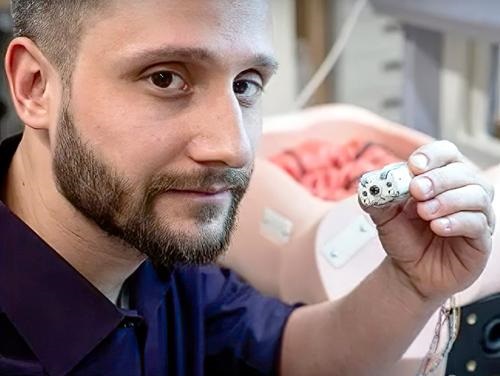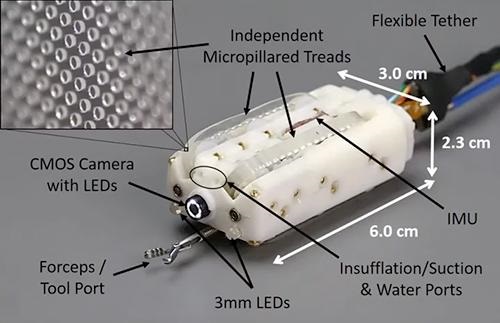GI pathologists will be interested in how the Endoculus device uses tank-like treads to traverse the gastrointestinal tract, where it can capture images and perform biopsies
Gastroenterologists (GI) may soon gain a useful new tool for use in gathering both biopsies and diagnostic information when examining the gastrointestinal tract. Ongoing development of a new robotic device promises both capabilities using technology that will be of interest to GI pathologists and clinical laboratory scientists.
Researchers at the University of Colorado Boulder’s Advanced Medical Technologies Laboratory (AMTL) have developed a capsule-sized robotic device called “Endoculus” which they believe could eventually replace traditional endoscopes used in colonoscopies and endoscopies.
The minute robotic device uses tank-like treads to traverse the colon. While there, it can capture live images and perform biopsies under the control of a gastroenterologist. The researchers believe the robotic technology will benefit GIs performing the colonoscopies as well as the pathologists called upon to analyze biopsies.

“Currently, endoscopy consists of a gastroenterologist using a semi-rigid, long rope-like device and endoscope to propel through your colon manually,” Gregory Formosa, PhD (above) a member of the AMTL team that developed Endoculus, said in a YouTube video describing the device. “We think that a robotic capsule endoscope can replace conventional endoscopes by making them faster, safer, and more robust than a human operator can do currently with traditional techniques,” he added. (Photo copyright: University of Colorado.)
AMTL researcher Gregory Formosa, PhD, said the team’s goal is to “have a capsule-sized robot that can actively traverse [a patient’s] entire gastrointestinal tract and send out diagnostics in real time, as well as autonomously navigate itself to localize problematic areas within [the] intestinal tract.”
Formosa noted that colorectal cancer is “the third-most fatal and diagnosed cancer in the United States.” But if caught at an early stage, these cancers are “95% treatable,” he added. “So, if we can get people screened early, we definitely can reduce the fatality rate of colorectal cancers significantly.”
The AMTL research team, now led by mechanical engineering professor Mark Rentschler, PhD, described an early prototype of the device in a Surgical Endoscopy paper, titled, “Surgical Evaluation of a Novel Tethered Robotic Capsule Endoscope Using Micro-Patterned Treads.” The researchers have since followed that with additional papers in IEEE journals and presentations at the IEEE International Conference on Intelligent Robots and Systems.

Currently about the size of a C battery, Endoculus (above) is a “fully packed medical device, complete with a camera, an air pump for inflating the colon, a water pump for cleaning, and a tool port for holding biopsy snares,” states a University of Colorado news story, titled, “A Robot May One Day Perform Your Colonoscopy.” (Photo copyright: University of Colorado.)
How Endoculus Works
One key to the device are the four treads, which are designed for traction on digestive tissue.
“You have to forget about everything you know from a locomotion standpoint because driving around inside the body is very different than driving around in a car,” said Rentschler in the University of Colorado news story. “The environment is highly deformable. It’s very slick. There are sharp peaks that you have to go over.”
The university news story noted the current availability of ingestible “pill cams” that can take photos as they travel through the digestive system. But once swallowed, their movements cannot be controlled.
“For our robots to be able to reach those regions that [can be] reached with a pill-cam—but also be able to stop and look around—that could be a big paradigm shift in the way we view these procedures,” said Micah Prendergast, PhD, an AMTL research team member.
Could Biopsies Be Diagnosed In Situ with Endoculus?
The researchers currently view Endoculus as a potentially better way to perform conventional biopsies. But could it lead to bigger advancements?
“Researchers continue to develop devices to help various specialist physicians—in this case GIs—do more when treating patients,” said Dark Daily Publisher and Editor-in-Chief Robert Michel. “This device fits that description. It is designed to improve the ability of GIs to evaluate the colon. Not only does this device do that, but it can also collect a biopsy at sites of interest. In this way, it is a device that can be a benefit to pathologists who will analyze the biopsy.
“With improvements in digital cameras and associated AI-powered analytical tools, the day might not be far off when a device like this can use the camera and artificial intelligence to diagnose the tissue of interest in situ,” he added. “This might create the opportunity for pathologists to be present in the exam room during the procedure, or even viewing the images remotely.
“Not only would that eliminate the need to collect a tissue specimen that must then be sent to a pathology lab, but it would create a new opportunity for pathologists to add value to patient care while shortening the time to diagnosis for the tissue of interest during these procedures,” Michel noted.
—Stephen Beale
Related Information:
Colon Explorer for Automatic Imaging and Biopsying of Polyps
This Tiny Robot Tank Could One Day Help Doctors Explore Your Intestine


